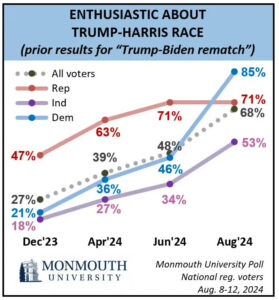In her Labor Day article, “Both Trump and Harris claim to support the working class: Where do they stand on labor?,” Kinsey Crowley writes at USA Today: “While Trump performed better than expected among Union workers in 2016, some of that support shifted back to President Joe Biden in 2020. Experts say that Biden’s popularity among union workers is likely to carry over to Harris. And unlike 2016, unions may be energized by the recent wins from several major strikes….”It suggests labor’s got some muscle and some fire in their tank,” Bob Bruno, director of the Labor Education Program at the University of Illinois Urbana-Champaign, told USA TODAY in an interview. “If you think you can win…you’re really gonna push a whole lot harder….The Harris campaign seems to tout Biden’s record as a pro-union president to justify the labor movement’s draw to Harris, and Celine McNicholas, policy director at nonpartisan research organization Economic Policy Institute Action, agrees….”There are parts of the Biden administration… (his) record on benefiting workers that I think Harris deserves unique credit on, because she was essentially the tie-breaking vote,” said McNicholas said….Harris also chaired the White House Task Force on Worker Organizing and Empowerment aimed at reducing barriers to unionization….The Harris campaign memo on working with unions detailed her pro-worker record dating back to her time as California Attorney General, when she addressed wage theft. While in office as a U.S. Senator, she walked picket lines in two strikes….if elected, Harris would pass the Protecting the Right to Organize Act. Known as the PRO Act, the bill would give workers more power to organize, and has passed the House multiple times but has not been signed into law.”

From an e-blast, “New GQR poll shows Americans want Increased Oversight on Corporate Greed”: “A recent GQR survey for More Perfect Union Foundation of 1,700 likely voters in seven battleground states—multimode survey in Arizona, Georgia, Michigan, Nevada, North Carolina, Pennsylvania and Wisconsin (multimode survey taken August 9-15, 2024; margin of error +/- 2.38– demonstrates broad support for government action to break up corporate monopolies and stop the price gouging that has raised the cost of every from groceries to rent to prescription drugs.
Key findings include:
- Voters still struggle with costs and majorities struggle to afford groceries (56 percent) and health care costs like premiums, deductibles and copays (51 percent).
- However, they are more likely to blame corporate greed and price gouging (61 percent) than high costs (51 percent) for inflation and rising costs.
- An 81 percent majority are “concerned that big corporations and businesses are becoming too powerful.”
- Huge majorities of voters support Biden’s efforts to rein in corporations including “right to repair,” reducing costs of cancer drugs, investigating big oil and breaking up monopolies. However, few voters know about these efforts.
- Voters respond better to an economic narrative that centers in controlling corporate concentration than a conservative nationalist argument.”
“The Latino vote has transformed over the last 15 years — and it’s now disproportionately younger than other groups, explains Mark Hugo Lopez from the Pew Research Center,” Adrian Carrasquillo writes at Politico. “Nationwide, 21 percent of young eligible voters in the U.S. are Latino. But in critical Southwest states, the numbers are even greater: Latinos comprise 39 percent of all 18 to 29 year old eligible voters in Arizona and 36 percent of those young voters in Nevada, according to Pew data from 2022….Today, of the roughly 4 million new Latino voters since 2020, about 3 million are U.S.-born Latinos who have come of age and are eligible to vote in 2024….Harris must now take a Hispanic voter engagement plan built for an 81-year-old white man and retrofit it on the fly for a lesser known, 59-year-old woman of color. Control of the White House could depend on that rebuild.” Carrasquillo cites “early data showing Harris far ahead of Biden with those [younger] voters. [Pollster] Barreto showed internal polling that had Harris’ net favorability advantage over Biden at 24 points with 18 to 24 year old Latinas, plus 17 with Latino men of the same age, plus 18 with Latinas aged 25 to 29, and plus 12 with Hispanic men 25 to 29….“This is extremely important,” Barreto later explained. “Younger Hispanic men looked problematic for Biden. They don’t look problematic for Harris. They start out pretty open-minded about her….In an expansive August 14 survey of 2,183 Hispanics, the polling firm found Harris leading Trump 56 percent to 37 percent across seven battleground states. Harris’ support among Latinos under 40 was especially robust — 17 points higher than Biden.”





